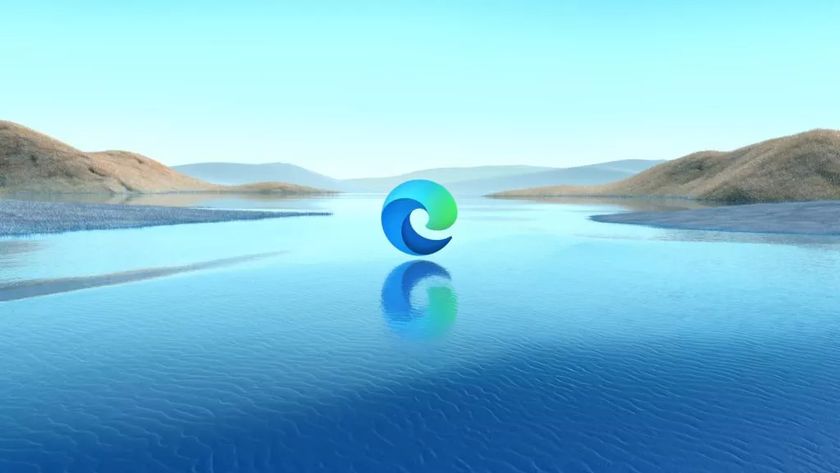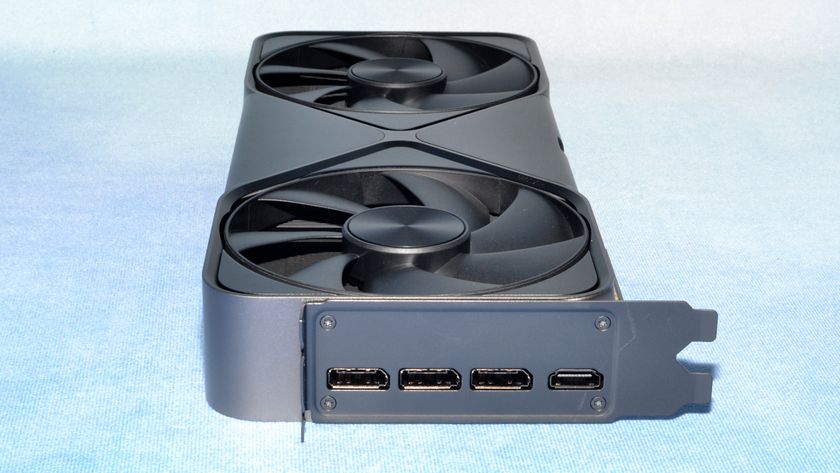Microsoft Build Keynote: Windows 10, Microsoft Edge, Continuum, HoloLens
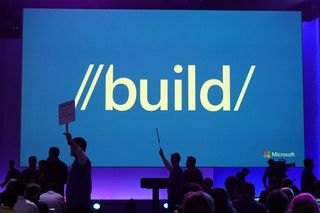
Today in San Francisco, Microsoft launched its Build 2015 dev conference with a lengthy keynote covering a variety of topics. We'll hit the high points here, but stay tuned for more in-depth coverage of these and other topics as the day (and week) progresses.
Windows 10: A Single Binary
Of course, Windows 10 is at the forefront of everyone's mind, and although Microsoft still hasn't dropped the official release date, we did get a glimpse into some of the new features. "This is not just another release of Windows," said CEO Satya Nadella, echoing sentiments he's expressed before. "It's another generation of Windows. Built for the era of more personal computing, where the mobility of experience across devices is what is paramount--not just the mobility of the device."
He stressed that Windows 10 will run across all manner of computing devices, from phones to tablets to desktops and beyond, because all of the Windows 10 experiences across them enjoy a shared binary. It's the same OS, just dressed up in slightly different clothes.
Devs will be able to easily integrate Xbox Live and Cortana into apps (or turn them into Holograms--more on that later).
The Windows Store has been gussied up to make app discovery more powerful and for the install/uninstall process to be smoother. There will be versions called Windows Store for Business, wherein companies or schools can have custom versions of the store. Store customers will enjoy carrier billing for Windows Phones and all Windows devices that are supported by some 90 mobile operators around the world.
We also got a look at a feature called Windows Spotlight that subtly nudges users toward engagement with apps and services they may not have seen via their lock screen. For example, the OS will make your lock screen background image something it thinks you may want to see. You can click a tiny "Like What You See?" icon and educate the OS on whether you'd like more or less of the same.
If the user hasn't tried out Cortana yet, or hasn't used other apps or features, other so-called "hotspots" will appear for users to click. Users can turn Windows Spotlight on or off.
Stay On the Cutting Edge: Get the Tom's Hardware Newsletter
Get Tom's Hardware's best news and in-depth reviews, straight to your inbox.
Universal Windows Platform Bridge SDKs: Bringing Android and iOS Apps (And More) To Windows 10
The Universal Windows platform is designed to further make porting apps to Windows 10 easier for devs. Microsoft is trying to make it a simple process, regardless of whether an app's code is on the web or is a .NET or Win32 application, but the killer here is the fact that developers will be able to bring their apps from Android and iOS to Windows 10 (and of course, thereby Windows 10 for phones).
Essentially, the way it works is that in Windows 10, Visual Studio can compile the Java, C++ or Objective-C code and extend it with Windows capabilities. In the demos we saw, ported apps ran essentially the same as they do in their native environments, but with Windows 10 graphics, virtual keyboard, Windows Security Container, and so on.
"Project Spartan" No More, Call It "Microsoft Edge"
Project Spartan, the browser that will eventually completely nudge out Internet Explorer for good in Windows 10, has a new name: Microsoft Edge.
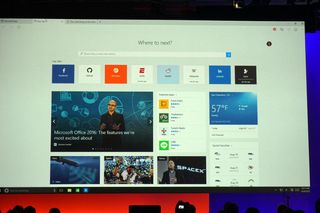
Microsoft Edge will run on a "wide range" of Windows devices, and Microsoft stated that it made the browser to help users "get things done." Cortana is built in, and it enjoys the other features we've seen already, such as distraction-free reading, and so on.
The company showed a version of Microsoft Edge where the user's top sites sit along the top of the windows, under the search bar. Under that is feature apps and news stories. The company showed off how to easily use web extensions to add functionality to sites--even ones pulled in from Chrome and gently modified, on Reddit and Pinterest.
Continuum, And Continuum For Phones
In a nutshell, Continuum is a tool designed to manage how apps display on different screens, and how they move and change on a single screen. It allows apps to "flex." For example, in a demo, we saw that Continuum allowed the user to easily switch between using a mouse and keyboard and then undock and use a pen or touch input. As the user resizes windows, we could see how Continuum resized the content--not just making it smaller, but re-presenting it in an attractive way.
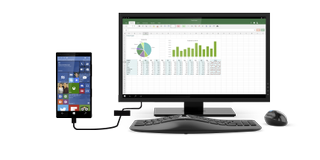
With Continuum for Phones, the capability is even more impressive. It effectively enables a phone's display to be seamlessly repurposed on a desktop monitor.
With the Windows Phone device connected to a display via HDMI (no, we didn't catch exactly how Microsoft pulled off that trick), the phone's Live Tile display popped up and looked like the desktop Start menu. When running apps from the phone, the look of each app jibed with the format of the larger display. It was so clean that we honestly would not have noticed unless we were told that the demo was happening.
Cortana's New Groove
We expected a little something on Cortana, Microsoft's AI assistant, and we did get a bit of new info. Cortana is getting a new UI in an upcoming Windows 10 build, and she's also getting some enhanced ways to launch apps. Microsoft wants the process of getting things done with Cortana to be as natural as possible. For example, you can ask her to open an app, and she'll do it. But, more powerfully, you can ask her to send one of your contacts a message via an app, and instead of opening the app, she'll just understand what you're trying to do and simply get your OK before she sends your message.
She'll also remember the apps you routinely use and suggest other related apps that you may want from the Windows Store.
HoloLens Looks Even Better
Microsoft demoed HoloLens, its radical augmented reality (or "holographic," depending on whether you use Microsoft's preferred nomenclature) headset, back in January. Today, the company showed off some impressive new tricks.
In a demo, which was augmented by a special camera that allowed the audience to more or less see what the HoloLens wearer could see, we watched as the demonstrator looked at apps such as a weather report (represented by a 3D island scene with weather info displayed on it), played a video "stuck" to a wall, and more.
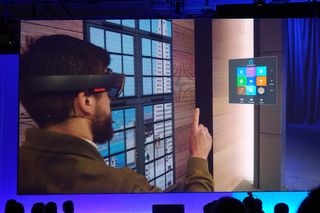
He pulled up a holographic Start menu and opened Skype. Then he dragged it over to the wall and stuck it there. Next, we wanted to play a video, and when he wanted to leave the room, he simply said "Follow me," and the screen came along with him. When he walked a bit, he stuck the video back on the wall.
It's also important to note that Windows Holographic is part of Windows 10's universal platform, so ostensibly, converting any Universal App to a hologram is relatively easy to do. To hear Microsoft tell it, it essentially boils down to a UI tweak.
The HoloLens hardware, which we still know next to nothing about, is most intriguing. The HoloLens is a completely standalone device. All of the CPU, GPU, camera, audio, and display technology is contained within that headset.
As we said at the top of this article, we have more coverage en route. Stay tuned.
Seth Colaner is the News Director at Tom's Hardware. Follow him on Twitter@SethColaner. Follow us@tomshardware, on Facebook and on Google+.
-
jimmysmitty I have to hand it to Microsoft and Satya. This is one of the best Microsoft Builds yet. Windows 10 is looking solid as is the Hololense.Reply
I was talking with a 20 year IT vet who said that this is what Microsoft is trying to do. A universal platform across all their devices. The ability to easily port apps from Android and iOS to 10 is just the cherry on top of the cake. They are the first to do this as well. It will be fun to watch Android and iOS push to do the same.
It will be interesting to see in the near future how it goes. I am excited to get to play with Windows. -
face-plants Very interested to see how Apple and Google handle the plans to support iOS and APK apps in Windows 10. The fact it will be capable of running these mobile apps is great. How do they plan on getting these apps installed is another matter. Will they somehow interface with the Apple and Google Play stores? Will you be able to install apps you've already paid for or do they need to be purchased again? Will this also take place in a parallel universe where Apple (and maybe Google) doesn't do everything in it's power to block a Microsoft OS from accessing it's app store?Reply -
turkey3_scratch This is actually very good stuff. Microsoft is finally getting smart in that they are finding easier ways for developers to actually spread their apps across platforms rather than recoding. Not sure exactly what Continuum will do but I'm hoping Microsoft is making an option for something like Nvidia surround built into Windows.Reply -
alextheblue ReplyVery interested to see how Apple and Google handle the plans to support iOS and APK apps in Windows 10. The fact it will be capable of running these mobile apps is great. How do they plan on getting these apps installed is another matter. Will they somehow interface with the Apple and Google Play stores?
They're not talking about running non-native apps. Blackberry tried that and it was less than optimal. They're talking about making it super easy for devs to port existing code, by supporting it in the new version of Visual Studio. The devs would have to do relatively minimal work to get their iOS or Android code compiled and running on Win10 platforms (including Phone) since it would require few changes.
This is the ideal solution since it means the code is precompiled and it's basically a native app - though a straight port might not be fully optimized. Obviously anything relying on outside code (games using licensed engines) would require a port of that, or a replacement for it. But if there's demand that will happen too. -
rokit Continuum - looks like idea that Linux people were pushing for many years yet didn't have money/enough interest to pull this off. I guess everything will be changed soon.Reply -
scolaner ReplyVery interested to see how Apple and Google handle the plans to support iOS and APK apps in Windows 10. The fact it will be capable of running these mobile apps is great. How do they plan on getting these apps installed is another matter. Will they somehow interface with the Apple and Google Play stores?
They're not talking about running non-native apps. Blackberry tried that and it was less than optimal. They're talking about making it super easy for devs to port existing code, by supporting it in the new version of Visual Studio. The devs would have to do relatively minimal work to get their iOS or Android code compiled and running on Win10 platforms (including Phone) since it would require few changes.
This is the ideal solution since it means the code is precompiled and it's basically a native app - though a straight port might not be fully optimized. Obviously anything relying on outside code (games using licensed engines) would require a port of that, or a replacement for it. But if there's demand that will happen too.
I'm told we'll get more in this during Day 2--stay tuned! -
agnickolov The bigger story for developers is that Visual Studio 2015 allows building using Clang and GCC using the actual Android NDK and iOS SDKs. It even supports Objective C now for iOS. There was a special session on that support in Visual C++ in the afternoon. And it's not just cross-compilation -- the complete IDE experience is there, including both IntelliSense and integrated debugging (using gdb and adb behind the scenes). That's a HUGE deal. Visual C++ even supports multi-platform builds from within the same project and highlights for you any non-portable code so you can fix it before it's even sent to the compiler. It needs more features before it can truly replace your Xcode (no OS X support - only iOS, no UI designers), but it's miles ahead of the Android NDK...Reply -
red77star Windows 10 business model comes with assumptions and those assumptions are wrong. People are not going to drop iPhone or iPads in favor of Windows and people are not going to drop Android powered Phones in favor Windows. Having said that this is going to be the most boring release ever. Honestly, there is nothing here to benefit me as PC user and i really don't need phone UI on my desktop.Reply -
game junky Running the tech preview hasn't been without it's quirks, but it's been a good experience and I will strongly consider doing a wide push to update at the office since it does a better job of allowing users to install apps without compromising the workstation. Will have to tinker with the finished copy of Edge to know if it will be good enough to keep people from downloading firefox and chrome on their workstations but so far so good - seems to render pretty quickly. It was also fun seeing the developer tools running with Azure - don't need the convenience enough to pull my hosted applications to the cloud but I understand why it's gaining momentum. Will have to try the release candidate once it's availableReply -
jimmysmitty Reply15778234 said:Windows 10 business model comes with assumptions and those assumptions are wrong. People are not going to drop iPhone or iPads in favor of Windows and people are not going to drop Android powered Phones in favor Windows. Having said that this is going to be the most boring release ever. Honestly, there is nothing here to benefit me as PC user and i really don't need phone UI on my desktop.
Wow I never have seen anyone tl;dr this much. The desktop wont have the phone UI. It will have a standard desktop design with a modernized start menu. The apps will run in windowed mode. Continuum will allow people to dock a phone to a monitor, hook up a Bluetooth mouse and keyboard and use it like a normal desktop. Visual Studio 2015 will allow developers to easily port applications fro iOS and Android to Windows, not just the phone but also desktop as apps for Windows will run on either desktop or mobile without the need to port it again.
In essence, if you have a Windows phone and desktop you will get a seamless experience. Neither Apple nor Google have anything close to that yet. iOS is a basic OS, nothing close to OSX. Android is a watered down OS that is not nearly as powerful as OSX or Windows is.
With that information, the Windows 10 business model is spot on. Give people the same experience across all their devices and as well give those who are glued to their phone the ability to use it as a portable desktop.
